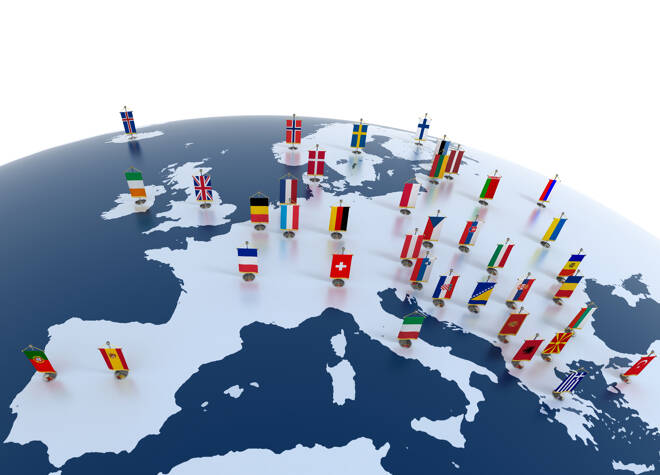Advertisement
Advertisement
Central and Eastern Europe: Growth Slows, Inflation Rises From War in Ukraine; ECB, EU Cushion Blow
By:
The economic impact of Russia’s war in the Ukraine will cut growth rates in half this year across central and eastern Europe and push inflation towards 10%. Extra ECB liquidity and direct EU support soften the economic blow for the region.
Scope Ratings expects average growth of the central and eastern European member states of the EU (CEE-11) to decelerate to 2-3% this year, a downward revision from our December forecast of 4.6%. Inflation could average close to 10% in the CEE-11 this year.
The readiness of the ECB to provide liquidity support to central banks in non-euro area EU countries is one key sign of European solidarity in the face of Russia’s further invasion of its western neighbour.
More Europe-wide support will emerge from discussions among European Union member states, perhaps along the lines of the Covid-19 EU Recovery and Resilience Facility alongside a reinforced commitment to helping CEE countries reduce their dependence on Russian energy imports.
CEE region especially vulnerable to consequences of the Russia-Ukraine war
The CEE region is especially vulnerable to consequences of this war beyond the region’s obvious proximity to Russia and refugees coming from the Ukraine. The military conflict and sanctions on Russia are stoking inflation by pushing up commodity prices – from oil and gas to metals, fertilisers and food – and disrupting supply chains while manifesting further volatility in financial markets.
Higher commodity prices in the run-up to the war’s escalation had contributed to turning current account surpluses into deficits in Poland (rated A+/Negative), Hungary (BBB+/Stable) and the Czech Republic (AA/Stable) or resulted in widening deficits as in Romania (BBB-/Stable) since the second half of 2021. Prolonged inflation risks squeezing the competitiveness of the region’s exporting sectors.
Conditions put the region’s central banks in a bind
These macroeconomic conditions put the region’s central banks in a difficult position. They need to manage inflation without jeopardising the economic rebound and excessively pushing up debt-servicing costs (Figure 1). Inflation expectations are rising. Currency volatility will persist amid potential capital outflows, putting pressure on foreign-exchange reserves even as regional central banks tighten monetary policy.
Figure 1. Debt financing costs for non-euro area CEE member states have increased materially
Local-currency government 10-year benchmark yields (%)*
The ECB’s decision to grant non-euro area central banks access to euro liquidity via new swap and extended repo facilities, originally established during the pandemic crisis, demonstrates wider EU readiness to offering further support, including fiscal help, tailored to abetting the most vulnerable CEE countries.
Under the new swap arrangement, Poland’s central bank can borrow up to EUR 10bn from the ECB, equivalent to around 7% of the country’s international reserves, in exchange for Polish zloty. Under a bilateral repo line, Hungary’s central bank can borrow up to EUR 4bn from the ECB, equivalent to around 11% of aggregate reserves, in exchange for adequate euro-denominated collateral. Such support has contained euro-denominated interest costs for CEE EU member states over previous crises given a sizeable share of euro borrowing in the region, of around 20% of public debt in cases of Poland and Hungary.
More EU-wide burden-sharing expected during this geopolitical crisis
We expect more EU-wide burden-sharing such as the almost EUR 17bn to help Ukrainian refugees and EU member states hosting the displaced persons. Poland has requested EUR 2.2bn from the EU budget in supporting Ukrainian refugees.
The war in Ukraine and sometimes differing approaches to it are changing intra-EU relations, notably between Brussels and its member states such as Poland and Hungary. While institutional disputes between Poland and the European Commission are unlikely to easily subside, the EU might unlock promised funding if the government in Warsaw displays greater respect for the rule of law.
Hungary, however, risks increased political isolation within the EU, increasing uncertainty over its stable inflow of EU funding over the medium run, as reflected in the EU’s upcoming initiation of a conditionality mechanism for Hungary linking EU budgetary financing to adherence to the rule of law.
CEE region holds multiple economic strengths, aiding the region’s resilience
The CEE region does hold multiple economic strengths. Foreign-exchange reserves of the central banks of Poland, the Czech Republic, and Hungary fully cover outstanding short-term external debt, an important shock absorber amid currency volatility. Romania’s reserves cover nearly 90% of its short-term external debt. Croatia (BBB-/Positive) and Bulgaria (BBB+/Stable), as candidates for euro adoption, benefit from membership in the EU’s Exchange Rate Mechanism II and Banking Union, ensuring their close cooperation with the ECB.
For a look at all of today’s economic events, check out our economic calendar.
Levon Kameryan is Senior Analyst in Sovereign and Public Sector ratings at Scope Ratings GmbH. Jakob Suwalski, Director in Sovereign and Public Sector ratings at Scope Ratings, contributed to writing this commentary.
About the Author
Levon Kameryancontributor
Levon graduated with a M.Sc. in International Economics and Public Policy from the University of Mainz in 2016. Levon worked previously as an economist at the Central Bank of Armenia.
Advertisement
